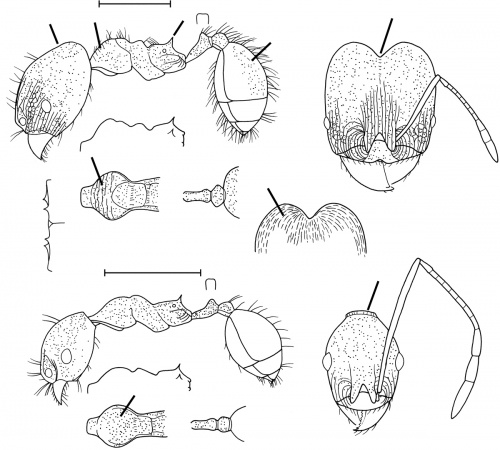Pheidole fissiceps
| Pheidole fissiceps | |
|---|---|

| |
| Scientific classification | |
| Kingdom: | Animalia |
| Phylum: | Arthropoda |
| Class: | Insecta |
| Order: | Hymenoptera |
| Family: | Formicidae |
| Subfamily: | Myrmicinae |
| Tribe: | Attini |
| Genus: | Pheidole |
| Species: | P. fissiceps |
| Binomial name | |
| Pheidole fissiceps Wilson, 2003 | |
Nothing is known about the biology of fissiceps.
Identification
See the description in the nomenclature section.
Keys including this Species
Distribution
Only known from the type locality.
Latitudinal Distribution Pattern
Latitudinal Range: -0.6258° to -12.043°.
| North Temperate |
North Subtropical |
Tropical | South Subtropical |
South Temperate |
- Source: AntMaps
Distribution based on Regional Taxon Lists
Neotropical Region: Peru (type locality).
Distribution based on AntMaps
Distribution based on AntWeb specimens
Check data from AntWeb
Countries Occupied
| Number of countries occupied by this species based on AntWiki Regional Taxon Lists. In general, fewer countries occupied indicates a narrower range, while more countries indicates a more widespread species. |

|
Estimated Abundance
| Relative abundance based on number of AntMaps records per species (this species within the purple bar). Fewer records (to the left) indicates a less abundant/encountered species while more records (to the right) indicates more abundant/encountered species. |

|
Biology
Castes
Worker
Minor
Images from AntWeb

| |
| Not Provided. Worker. Specimen code casent0282930. Photographer Adam Lazarus, uploaded by California Academy of Sciences. | Owned by EPEC. |
Nomenclature
The following information is derived from Barry Bolton's Online Catalogue of the Ants of the World.
- fissiceps. Pheidole fissiceps Wilson, 2003: 145, figs. (s.w.) PERU.
Unless otherwise noted the text for the remainder of this section is reported from the publication that includes the original description.
Description
A member of the biconstricta group, similar to Pheidole biconstricta, Pheidole plato, Pheidole simplex and Pheidole socrates, easily distinguished as follows.
Major: deep midoccipital cleft; large propodeal spines; flat profile posterior dorsal surface of the head; aligned appressed pilosity of the dorsal head surface; transversely carinulate pronotal dorsum.
Minor: tapered occiput with well-developed occipital collar.
MEASUREMENTS (mm) Holotype major: HW 1.56, HL 1.70, SL 1.18, EL 0.22, PW 0.74. Paratype minor: HW 0.58, HL 0.78, SL 1.06, EL 0.16, PW 0.40.
COLOR Major and minor: concolorous yellow.
Figure. Upper: holotype, major. Lower: paratype, minor. Scale bars = 1 mm.
Type Material
PERU: Estácion Biologia de Cocha Cashu,Madre de Dios Prov., 400 m col. Diane W. Davidson. Museum of Comparative Zoology
Etymology
L fissiceps, cleft head, referring to the deep median occipital cleft.
References
- Wilson, E. O. 2003. Pheidole in the New World: A dominant, hyperdiverse ant genus. Harvard University Press, Cambridge, MA. (page 145, fig. major, minor described)
- Franco, W., Ladino, N., Delabie, J.H.C., Dejean, A., Orivel, J., Fichaux, M., Groc, S., Leponce, M., Feitosa, R.M. 2019. First checklist of the ants (Hymenoptera: Formicidae) of French Guiana. Zootaxa 4674, 509–543 (doi:10.11646/zootaxa.4674.5.2).
References based on Global Ant Biodiversity Informatics
- Davidson, D.W. 2005. Ecological stoichiometry of ants in a New World rain forest. Oecologia 142:221-231
- Fernández, F. and S. Sendoya. 2004. Lista de las hormigas neotropicales. Biota Colombiana Volume 5, Number 1.
- Franco W., N. Ladino, J. H. C. Delabie, A. Dejean, J. Orivel, M. Fichaux, S. Groc, M. Leponce, and R. M. Feitosa. 2019. First checklist of the ants (Hymenoptera: Formicidae) of French Guiana. Zootaxa 4674(5): 509-543.
- Mertl, A.L. and J.F.A. Traniello. 2009. Behavioral evolution in the major worker subcaste of twig-nesting Pheidole (Hymenoptera: Formicidae): does morphological specialization influence task plasticity? Behavioral Ecology and Sociobiology 63:1141-1426
- Mertl, A.L., K.T. Ryder Wilkie and J.F.A. Traniello. 2009. Impact of Flooding on the Species Richness, Density and Composition of Amazonian Litter-Nesting Ants. Biotropica 41(5):633-641


